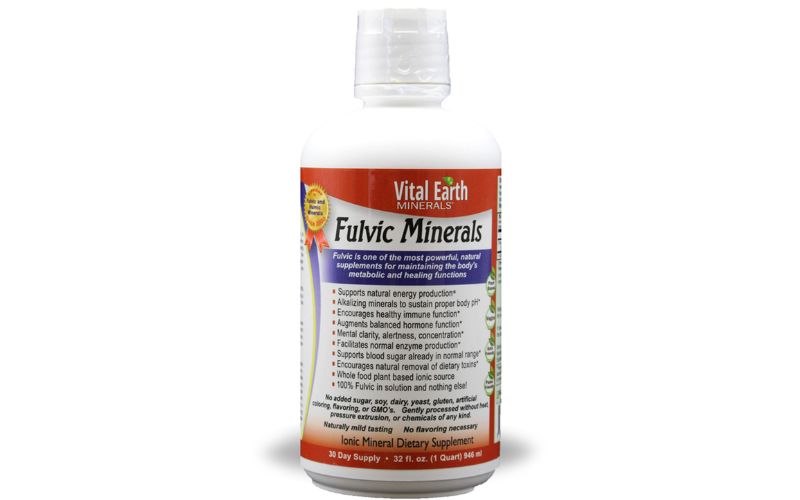How to Incorporate Fulvic Acid into My Diet
15th May 2025
In pursuing better health and increased energy, people are becoming more aware of naturally occurring nutrients that once went unnoticed. Fulvic acid is one such nutrient, a powerful compound formed when microbes in soil break down plant matter over long periods. More people around the world are discovering its benefits.
Fulvic acid contains various trace minerals, electrolytes, amino acids, and antioxidants that support general vitality. It helps enhance the body's natural nutrient absorption, promotes hydration at the cellular level, and may even aid energy production. If you're curious about how to introduce fulvic acid into your daily routine, you're not alone. This guide will walk you through its natural sources, supplementation options, and tips for integrating it seamlessly into your diet.
Unlock the power of Fulvic Acid to revitalize your energy, health, and well-being.
What Is Fulvic Acid?
Fulvic acid is a component of humic substances found in soil, peat, coal, and certain bodies of water. It is formed during the decomposition of plant and microbial matter, a slow, natural process that produces a complex blend of nutrients.
What makes fulvic acid interesting is its small molecular size. This allows it to carry and deliver nutrients deep into cells more effectively than many other substances. It also acts as a natural transporter, helping your body better use the vitamins and minerals you consume from food or supplements.
Natural Food Sources of Fulvic Acid
Fulvic acid is not usually found on nutrition labels, but some foods contain it based on how they are grown. Although these foods may not have as much fulvic acid as supplements, they still make good choices for a diet that includes fulvic acid.
1. Shilajit
This resin-like substance is found primarily in mountainous regions, especially in the Himalayas. Shilajit is perhaps the richest natural source of fulvic acid. Traditionally used in various health practices, it is often consumed as a resin or powder. A pea-sized amount diluted in water or milk can provide substantial fulvic acid.
2. Seaweed and Algae
Marine plants like spirulina, chlorella, and kelp are dense in nutrients and contain traces of fulvic acid. These foods thrive in mineral-rich waters, making them a great indirect source.
Spirulina or chlorella powder can be added to smoothies or taken as tablets. Seaweed can also be included in salads and soups or as crispy snacks.
3. Compost-Rich Vegetables
Fruits and vegetables grown in nutrient-dense soil, especially those from small, regenerative farms, are more likely to retain trace amounts of fulvic acid. While mass-produced crops may not be as rich in these compounds, produce grown with traditional, soil-enriching methods can carry more natural minerals.
Look for fruits and vegetables like carrots, beets, radishes, and potatoes from such sources.
4. Blackstrap Molasses
This byproduct of sugarcane processing is surprisingly nutrient-rich. While not a direct source of fulvic acid, it often contains trace minerals commonly found in fulvic compounds. Use it as a natural sweetener in oatmeal, smoothies, or baked goods.
Supplementing With Fulvic Acid
Although food sources can offer some fulvic acid, supplements are a more reliable way to ensure consistent intake, especially for those with limited access to certain foods or specialized farming practices.
1. Fulvic Acid Drops or Liquids
Liquid fulvic acid supplements are among the easiest to use and most bioavailable. A top choice is the Fulvic Mineral Complex by Vital Earth Minerals. This supplement provides a rich blend of fulvic minerals in liquid form, designed to support natural nutrient uptake, hydration, and cellular energy.
Simply mix the recommended amount into water, juice, or a smoothie. Its natural taste blends well, especially in flavored drinks. Ideal for morning routines, this fulvic acid helps you better absorb your daily nutrients.
2. Fulvic and Humic Acid Blends
Consider supplements that combine fulvic and humic acids for a broader range of benefits. These two synergistically support mineral transport, hydration, and general wellness. One excellent example is Vital Earth Minerals' Mineral Blend Fulvic-Humic.
This blend is crafted to deliver trace minerals in a balanced formula that’s easily absorbed. It can be added to any beverage and is perfect for people looking to enhance their daily mineral intake while supporting optimal nutrient assimilation.
3. Mineral Complexes
Other fulvic acid supplements contain trace minerals such as magnesium, zinc, and iron. This combination effectively enhances uptake and stimulates daily mineral equilibrium, making them ideal for individuals seeking to improve their nutritional profile.
How To Incorporate Fulvic Acid Into Your Lifestyle
Adding fulvic acid to your life need not be complicated. Here are simple means of incorporating it into your way of life:
1. Morning Routine
Begin the morning by mixing a few drops of fulvic acid into your initial glass of water. This aids in hydration and prepares your body to absorb nutrients better throughout the day.
2. Smoothie Boost
Fulvic acid supplements are quality smoothie add-ins, particularly powdered or liquid ones. Mix them with greens, berries, bananas, and plant-based milk for a mineral-laden breakfast or snack.
3. Pre-Workout Hydration
Add fulvic acid to your pre-workout beverage to replenish electrolytes and enhance hydration. Most fitness enthusiasts appreciate that it works well within nutrition routines without drastically changing taste.
4. Preparing Meals with Fulvic-Rich Ingredients
Use seaweed to add to soups or stews, prepare meals with root vegetables cultivated in compost soil, and use molasses as a sweetener when baking or making sauces. Gradually, minor adjustments of this nature can enhance overall consumption.
Things To Consider Before Buying Fulvic Acid
Before purchasing a fulvic supplement, take these into account:
Quality Matters
Fulvic acid supplements are not all the same. Choose products that are tested for purity and concentration by third-party organizations. Since fulvic acid comes from natural sources, contaminants are problematic if not properly filtered and purified.
Serving Size and Frequency
Stick to the recommended dosage. More is not necessarily better. Pay attention to how you feel, especially in the first week or two, and consider consulting a nutritionist if you're combining fulvic acid with other supplements.
Taste and Adaptation
Fulvic acid has a naturally mild taste, especially in liquid form. If this is off-putting, blend it into flavored beverages rather than taking it straight. Over time, many users find the taste grows on them, or becomes unnoticeable when mixed properly.
Who Should Consider Fulvic Acid?
Fulvic acid may appeal to:
- Busy professionals looking to enhance their daily nutrient intake
- Athletes interested in better hydration and mineral support
- People seeking more natural ways to feel energized throughout the day
- Individuals committed to nutrient-dense, soil-based nutrition
It fits well into a balanced diet focused on whole foods, hydration, and mindful supplementation.
Final Thoughts
Fulvic acid is one of those hidden gems in the world of nutrition. While it might not be a household name yet, its unique ability to support nutrient absorption and cell-level vitality is attracting more attention every day.
Combining natural food sources with targeted supplementation can gradually and effectively introduce fulvic acid into your daily life. Consistency is key when you’re sipping it in your morning water or sneaking it into your smoothie. Over time, you may notice subtle energy, hydration, and overall wellness improvements.
Frequently Asked Questions
Can I take fulvic acid every day?
Yes, according to recommended guidelines, fulvic acid is generally safe for daily use. Always start with the minimum suggested dose and listen to your body.
Does fulvic acid have a taste?
Fulvic acid has a mild, all-natural taste, especially in liquid form. Most people find it manageable when mixed with juice or smoothies.
How soon will I notice the results?
Some individuals report feeling more hydrated or energized within a week, while others may take a few weeks to notice subtle benefits. The time it takes to notice subtle benefits varies depending on diet, lifestyle, and dosage.






